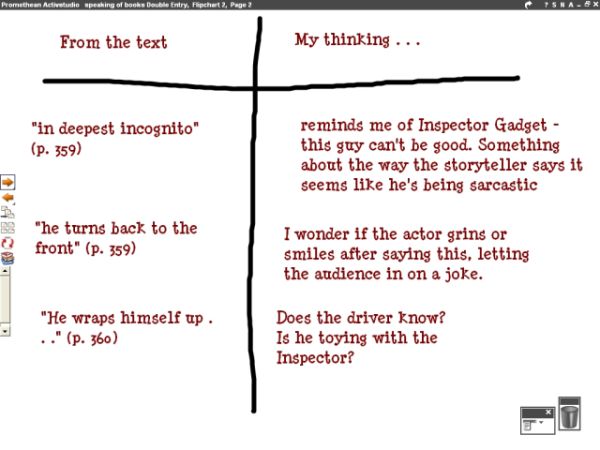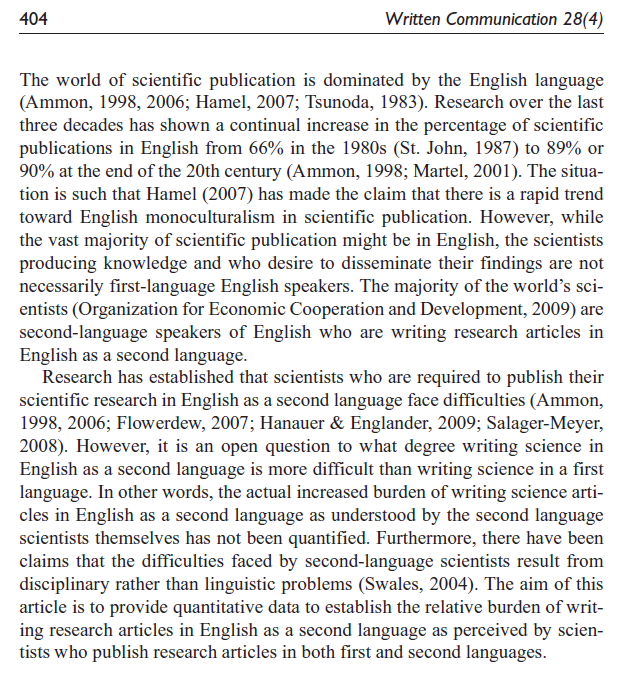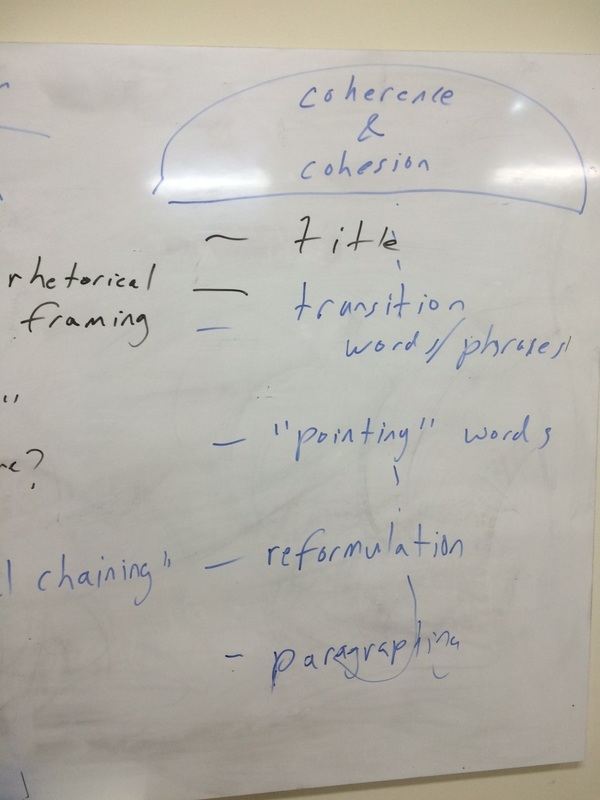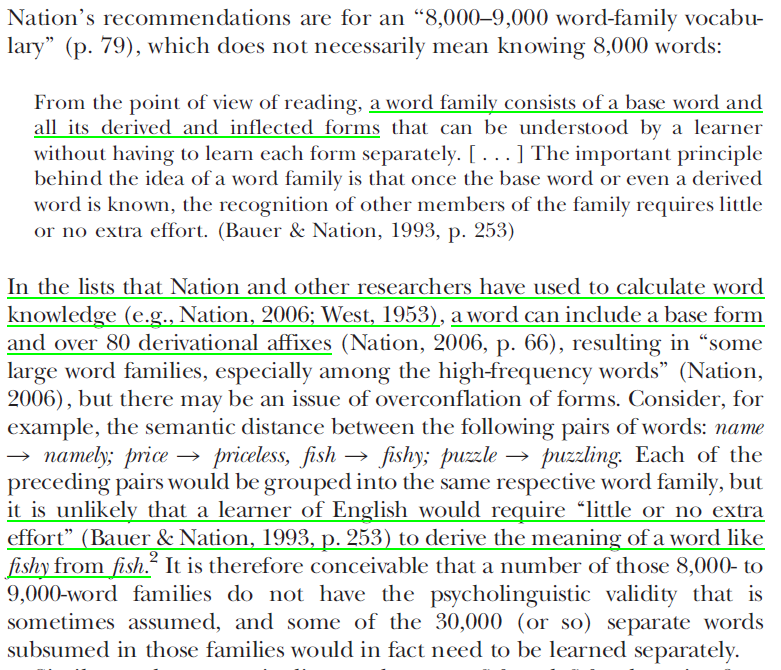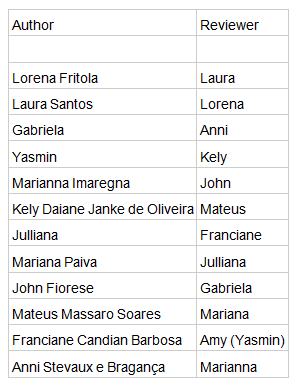LINGUA INGLESA ESCRITA IV (HE285)
Professor: Dr. Ron Martinez
Office: 1014 (Reitoria)
CLASS DOCUMENTS
FINAL PAPER REVIEWER CHECKLIST
Reading Engagement Log
MIDTERM Rubric
FINAL Rubric
VIDEO TUTORIAL:How to do a "lexical profile" (find word frequency
information) for your essays:
information) for your essays:
LIBRARY
Link to "Portal de Periódicos" CAPES
Instructions for "conexão doméstica" (to access research portals)
Instructions for accessing journals through CAFe
"Treinamento no uso do Portal de Periódicos"
READINGS
Casanave, C. P. (2008). ‘‘The stigmatizing effect of Goffman’s stigma label: a response to John Flowerdew’’. Journal of English for Academic Purposes, 7, 264-267.
Flowerdew, J. (2008) Scholarly writers who use English as an Additional Language: What can Goffman’s ‘‘Stigma’’ tell us? Journal of English for Academic Purposes, 7, 77-86.
Flowerdew, J. (2009) Goffman’s stigma and EAL writers: The author responds to Casanave. Journal of English for Academic Purposes, 8, 69-72.
Hanauer, D.I., & Englander, K. (2011). Quantifying the burden of writing research articles in a second language: Data From Mexican scientists. Written Communication, 28(4), 403-416.
Miller, T., & Parker, D. (2012). Writing for the reader: a problem-solution approach. English Teaching Forum, 3, 21-27.
Swales, J., & Najjar, H. (1987). The writing of research article introductions. Written Communication, 4(2), 175-191.
Thompson, G. (2001). Interaction in academic writing: Learning to argue with the reader. Applied Linguistics, 22(1), 58-78.
Wingate, U. (2012). 'Argument!' helping students understand what essay writing is about. Journal of English for Academic Purposes, 11, 145-154.
ACADEMIC VOCABULARY LISTS
The Phrasal Expressions List (Martinez & Schmitt, 2012)
The Academic Collocations List (Ackermann & Chen, 2013)
The New Academic Vocabulary List (Gardner & Davies, 2013)
The Academic Formulas List (Ellis & Simpson-Vlach, 2010)
LINKS
APA Formatting (Purdue University)
ABNT Formatting
Meaning and use of Latin abbreviations
Vocabulary Frequency Profiler (LexTutor)
Sketch Engine for Language Learning
CLASS CALENDAR
WEEK 1
Your browser does not support viewing this document. Click here to download the document.
TAKE THE CLASS SURVEY!Create your free online surveys with SurveyMonkey , the world's leading questionnaire tool. QUIZ: WHAT ARE YOUR BELIEFS ABOUT ACADEMIC WRITING?If survey (above) does not appear automatically, please click here."SUBTEXT" -- THE STORY OF AN EMAIL
|
CLASS VOCABULARY LISTdefurther hence in order to widely pinpoint hedge slant bias overt novice skillfully stance entail warrant amid detrimental OOPS (mistakes to avoid)"researches" (research is not usually countable)
"related with" (related to) "incorporate to" (incorporate into) "the problem about" (the problem with) "the effect of ___ in ____" (the effect of ___ on ___) |
PART 1 (WEEK 4)
PART 2 (WEEK 5)
COMMENT ON YOUR CLASSMATES' BLOGS
Read some of your classmates' texts and comment on at least one.
EX. 1 - WHAT'S THE HYPOTHESIS?
Read the abstract for this article and then discuss what the hypothesis was of the researchers.
EX. 2 - ANALYSIS OF ESSAY INTRODUCTIONS
Read the three essay introductions and identify where the authors establish territory, establish niche, and occupy niche. DOWNLOAD HERE
EX. 3 - HOW DO AUTHORS "ESTABLISH TERRITORY?"
- Visit the Journal for English for Academic Purposes (at ScienceDirect).
- Browse the journals, looking for articles that interest you.
- Skim over the introductions of at least 5 articles, and note the way the author(s) "establish territory."
- Focus especially on the first 2 sentences of the Introduction section (NB: not the Abstract). (Notice how their function is often to "claim centrality" -- although other functions, such as "defining" are also common.)
- Make a "collection" of phrases/sentences you think are worth recording. Be sure to underline/highlight the part you think is useful.
- Be sure to note not only the phrase/sentence, but also the link to the source article.
- When done, copy and paste onto the Google doc.
EX. 4 - WHERE IS THE "NICHE"?
There are two "however"s in the Introduction below. Which one represents the beginning of the author's establishment of niche? Or are there two niches?
EX. 5 - TO CITE OR NOT TO CITE?
Without looking at the original article (!!!), download the introduction and find the the missing in-text citations. (There are 6 of them.) DOWNLOAD HERE
PART 3
HOMEWORK: FINISH THE 'FAKE CITATION' EXERCISEAccess the Google Doc here.
|
WEEK 8 (April 25)
MIDTERM PREPARATION
EX. 1 - IDENTIFY THE 'C.A.R.S.' MOVES
Access this article and identify where the moves are in the Introduction section. (If you do not have an UFPR email, you may share with a classmate.)
Your browser does not support viewing this document. Click here to download the document.
EX. 2 - HOW DO WRITERS "OCCUPY TERRITORY" IN RESEARCH ARTICLES?
Access the Journal of Second Language Writing here. What are some of the common ways (i.e. phrases) authors use to occupy a niche? Makes notes.
WEEK 9 (May 1)
MIDTERM REVIEW
LANGUAGE LESSONS FROM THE MIDTERM - DOWNLOAD HERE
HOMEWORK NEXT WEEK: "ARGUING WITH THE READER": Quantifying the burden of writing research articles in a second language. Download the full article here, and the worksheet here.
WEEK 11 & 12 (May 16; May 23)
WRITING FOR THE READER IN THE TEXT
FIND THE "READER IN THE TEXT": Download Flowerdew (2008) and try to find at least 2 examples. Copy and paste them onto a Word document.
HOMEWORK FOR 20/05: 1) Read pp. 86-90 in "They Say, I Say". 2) Choose one topic and Respond to the "reader-in-the-text" - Download worksheet here.
HEDGING: EPISTEMIC MODALITY |
|
Access here the Google Doc we worked on in class, and use for future reference in your writing.
HOMEWORK FOR 23/05: POST ON YOUR BLOGS YOUR TEXTS FROM YOUR WORKSHEETS (for example, the "Curitiba sidewalks" text), AND THE "CRAZY THEORIES" TEXTS FROM TODAY'S CLASS - see an example here.
HOMEWORK FOR 30/05
- Read the chapter "As a result" on p. 105 of "They Say/I Say"
- Complete this worksheet.
- Check your answers on the original article (see bottom of p. 10 of the journal article).
- Write down at least 1 "working title" (and a maximum of 3) for your final paper. Please bring your title(s) to the next class.
- Identify at least 1 "textual mentor" -- a text that you will analyze for features that you think are worth copying, reusing or otherwise emulating.
- Read and comment on the blogs of at least 2 classmates.
WEEK 13 (May 30)
CONNECTING THE PARTS
SEE ANSWERS TO THE BUSINESS ARTICLE COHESION HOMEWORK HERE.
HOW WELL DOES THE TEXT COHERE?
1. Analyse this text for aspects of coherence and cohesion.
2. How can the text be improved?
2. How can the text be improved?
TODAY'S BOARD NOTES ON COHERENCE AND COHESION
YOUR WORKING TITLES
See your classmates' working titles here - and don't forget to update yours!
WEEK 13 (June 3rd)
The Home Stretch
1. SCHEDULE YOUR BLOG FEEDBACK CONSULTATIONS HERE.
2. CHOOSE YOUR PEER REVIEWER HERE.
3. SAMPLE FINAL PAPER HERE.
WEEK 14 (June 10th)
Some final touches
CAN YOU SPOT PLAGIARISM? TAKE THE TEST!
In case the embedded form does not load, you can also access the test here.
HOMEWORK
1. APA REFERENCING WORKSHEET (Download HERE)
2. APA REFERENCING EXAMPLE ARTICLE -- HERE.
WRITE A SHORT PARAGRAPH THAT IS BASED ON THE UNDERLINED PART OF THE TEXT BELOW, TAKEN FROM MARTINEZ AND MURPHY (2011, p. 270).
WEEK 15 (June 13th)
Peer review
>> PEER REVIEW CHECKLIST FOR THE FINAL PAPER
DOWNLOAD THE PEER REVIEW CHECKLIST HERE.
|
|
This student's essay received a good score, but there is a section in the essay that I felt should be deleted. Why? Download the sample here.
2. SCREENCAST-O-MATIC DEMO
Access the demonstration here.
3. DEALING WITH COLOR CODES
Download the worksheet here and work with a partner to identify why the codes have been used, and what needs to be changed (and how).
4. ENHANCING YOUR VOICE
Remember the importance of lexical diversity and cohesion. Download the worksheet here.
